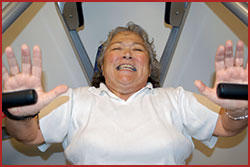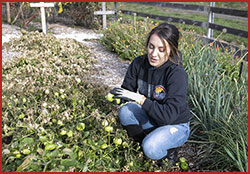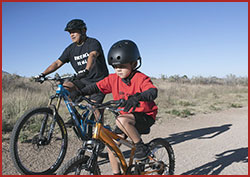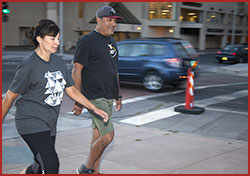Being Active is Traditional
Being Active is Traditional
For generations, Native people have lived active lives: growing crops, hunting, fishing, and gathering berries, herbs, and traditional medicines. Cultural ways are active, such as dancing, running, drumming, carving, and playing games. Being active improves mental and spiritual well-being—it is good medicine.
Movement helps muscles use sugar for energy, which may improve blood sugars. Any increase in movement is good for you.
Share

Melva, doing a chest press at the gym.
I learned that exercise could mend this old body. I found out that exercise is the key. I found out I can control diabetes. I am the person who has to take care of my body. It is up to me to stay well. It’s so simple.
Why be active?
- Feel less stress and have a happier mood.
- Increase strength, balance, and flexibility.
- Improve blood sugar, blood pressure, and cholesterol levels.
- Achieve or maintain a healthy weight.

How to get started
- Talk with your health care team about what is safe and best for you.
- Set a day and time for your activity, and write it on your calendar.
- Ask a friend to join you.
- Plan indoor and outdoor activities.
Fun ways to get moving
- Gardening, gathering berries and greens, and doing yardwork.
- Yoga and tai chi for balance and flexibility.
- Brisk walking, hiking, jogging, swimming and bike riding.
- Fitness classes and strength training.
- Chair exercises and arm movements.
- Do what you enjoy!

How much activity to do
If you miss a few days of walking, don’t be hard on yourself or give up. Things happen in life.
- Start slowly, even if it is 5 or 10 minutes a day, and build up from there.
- If sitting a lot, try to get up and move every 30 minutes.
- Try to increase your activity to 150 minutes a week, over three or more days.
Be safe when being active
- Choose a safe place. If you have a cell phone, take it with you.
- Check blood sugar before and after exercise. If less than 100, eat a food or drink with sugar, such as, a half cup of juice, or small fruit, or a few pieces of hard candy. For more information see, Low Blood Sugar.
- Bring water and stay hydrated.
- Bring hard candy (not sugar-free) or glucose tablets in case your blood sugar drops too low while being active.
- Warm-up and cool down. Go at a slower pace at the start and end of your activity.
- Wear comfortable shoes. Check your feet for sores, cuts, blisters, corns, or redness before and after exercise, as well as daily. Let your provider know if you find any of these.

Take care of yourself and your spirit
Any increase in movement is good for you. Even adding chair exercises or arm movements helps you to be more active.
You may start with a slow walk at first. The more you do it, the farther you can walk and the stronger you will get. For more information see, How to Get Started Walking.
Being active often brings peace and a feeling of pride. Your family will see how hard you have been working and how it is helping to manage your diabetes. They will be proud of you too!


